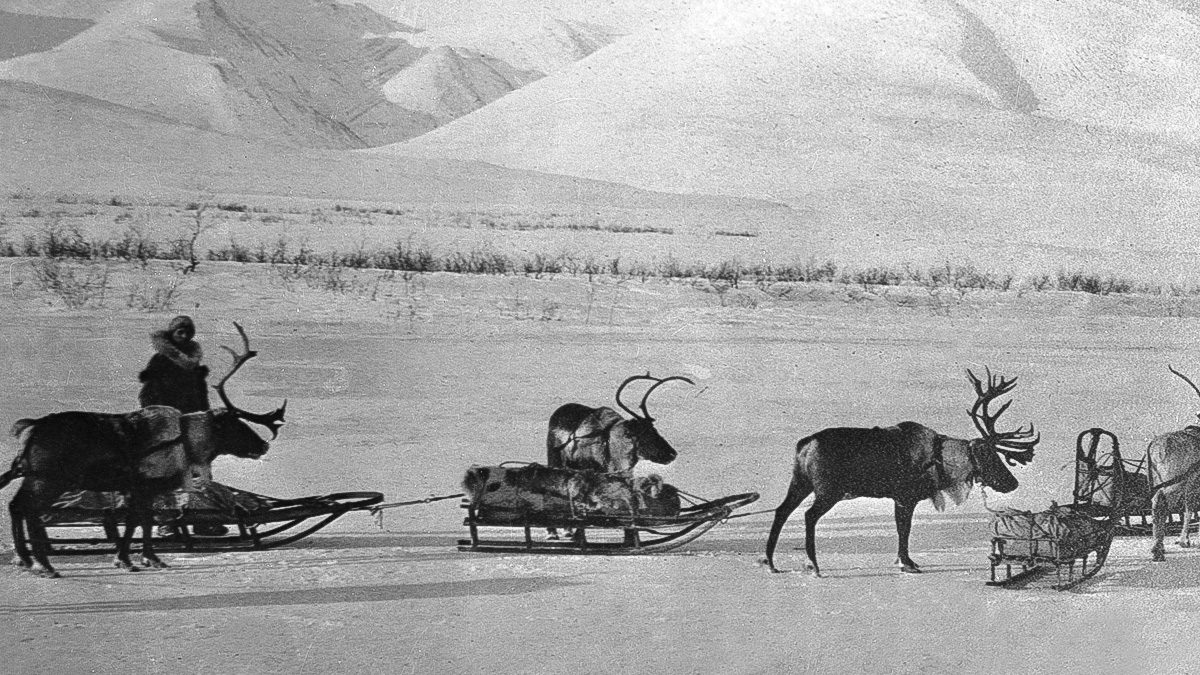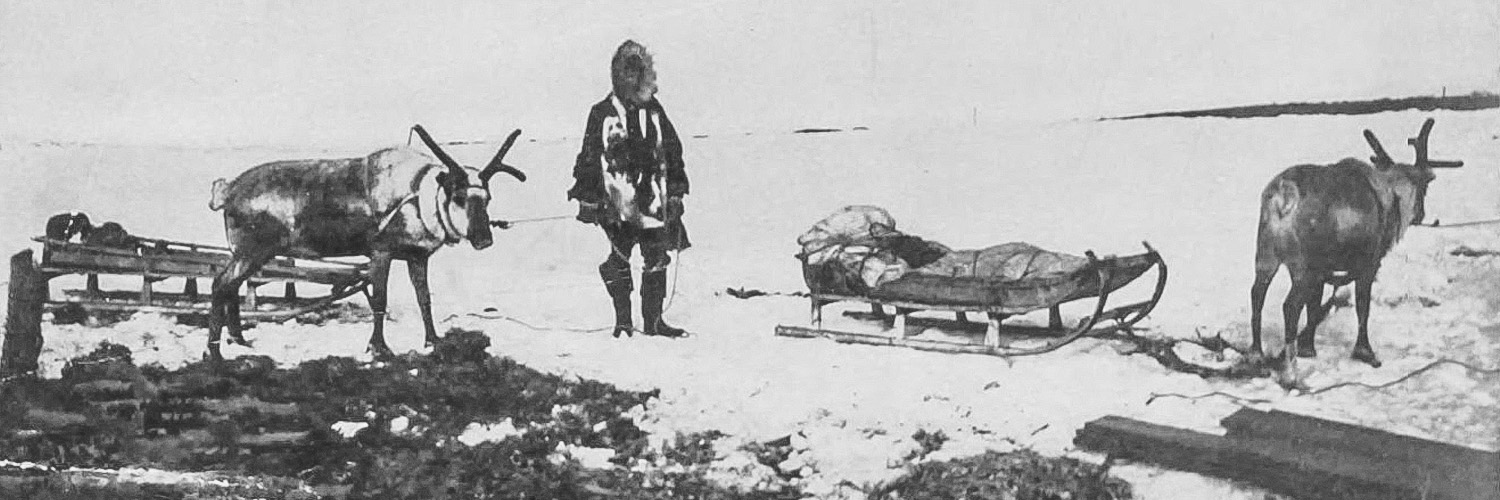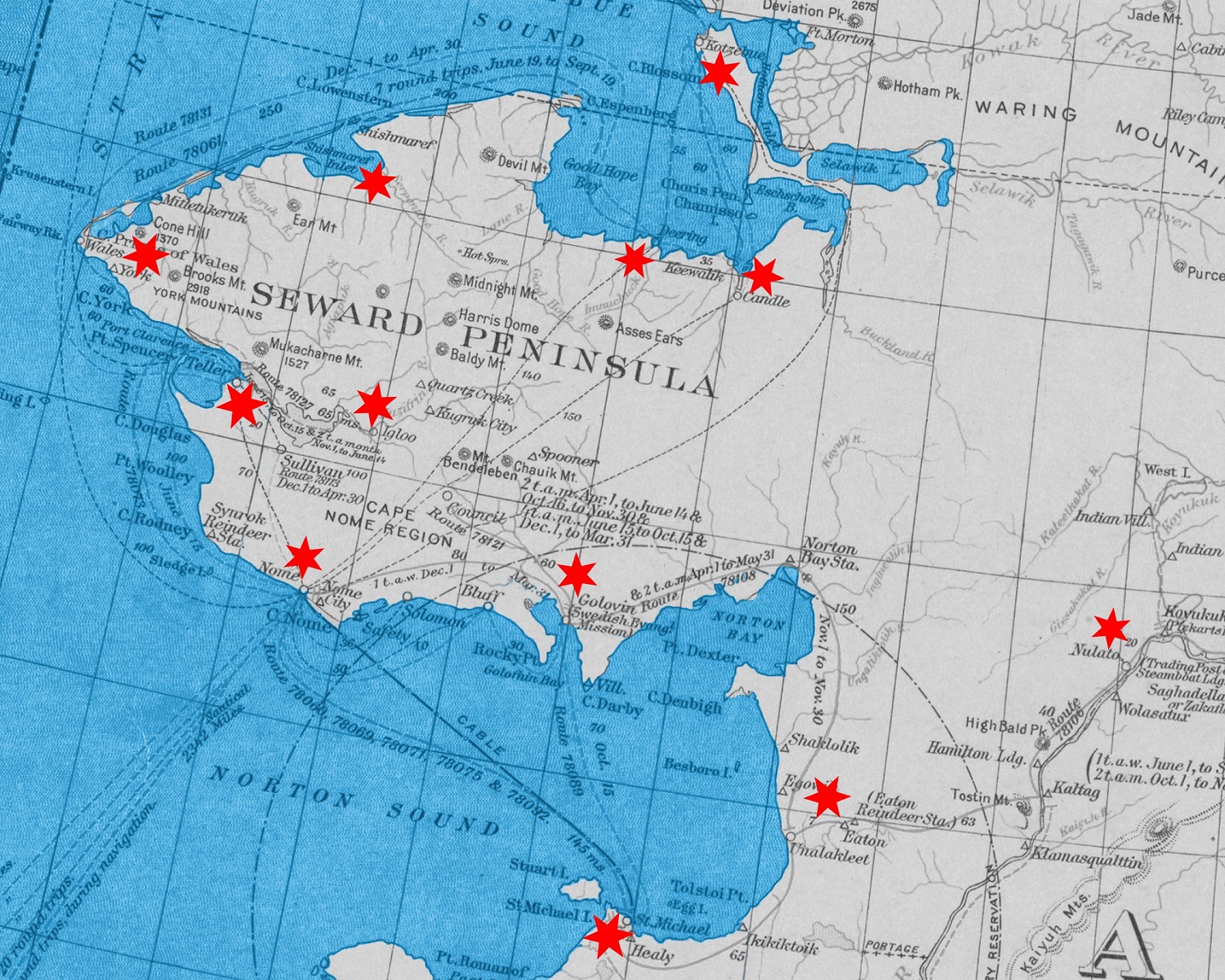
Reindeer with sleds of mail in Alaska, undated. USPS collection.
When Reindeer Moved the Mail
Many of us learned as children that reindeer help Santa Claus deliver toys to children worldwide on the night before Christmas. But few of us may know that reindeer also once helped deliver U.S. Mail in Alaska. From 1899 to the early 1910s, reindeer helped transport mail to more than a dozen Post Office locations in northwestern Alaska, including several located north of the Arctic Circle.
Why reindeer?
Unlike caribou, which were native to Alaska, semi-domesticated reindeer were imported to Alaska in the 1890s. Sheldon Jackson, a Presbyterian missionary and the General Agent of Education for Alaska from 1885 to 1908, believed reindeer would be useful for transportation in winter. Dogsleds, the traditional form of wintertime transportation, could not carry as much weight as sleds pulled by reindeer. Dogs also needed food to be prepared in advance and carried or cached along the route, whereas reindeer could feed themselves by foraging for lichen.
In his 1894 report to the U.S. Department of the Interior titled “Introduction of Domestic Reindeer into Alaska,” Jackson included a map showing “proposed reindeer mail routes” crisscrossing Alaska Territory. Jackson arranged for reindeer to be imported to Alaska from both Siberia and northern Scandinavia, accompanied by reindeer herders to teach the native Alaskans how to handle, care for and train the deer. Although Jackson’s vision of reindeer routes crisscrossing the territory never materialized, in the early years reindeer were used on several mail routes in northwest Alaska, from St. Michael, south of the Seward Peninsula, to the Barrow Post Office, north of the Arctic Circle.
The discovery of gold in Nome in 1898 led to the establishment of new Post Office locations to serve the thousands of fortune-seekers who came to northwestern Alaska. Most of the offices were located along the coast or inland waterways. In summer, the offices could be reached by boat, but during the long, frozen winters — the period of “closed navigation” — travel was extremely difficult. Traveling between Post Office locations was so time-consuming and dangerous that for decades some offices in Alaska received mail only two or three times each winter.

Reindeer routes
The first known use of reindeer to move the U.S. Mail was on Route 78110, St. Michael to Kotzebue, consisting of three 1,240-mile, 60-day round-trips beginning Dec. 1, 1899.
Shortly thereafter, reindeer were used to carry mail on the following routes:
- Eaton to Nome, a 480-mile roundtrip, beginning in March 1900
- Michael, Eaton and Nulato, a 400-mile roundtrip, in the spring of 1900
- Nome to Candle, a 520-mile roundtrip, in the winter of 1901-1902
The reindeer teams covered the distance from Nome to Candle in only eight days, roughly half the time required by dog teams.
During the winter of 1903-1904, reindeer were used on three mail routes —Teller to Wales (150-mile roundtrip), Teller to Igloo (130-mile roundtrip) and Barrow to Kotzebue (1,300-mile roundtrip).
The route from Barrow to Kotzebue was reportedly the longest and most dangerous in the world. In his “Thirteenth Annual Report on the Introduction of Domestic Reindeer into Alaska” (1903), Sheldon Jackson described the trips on this route being made “through a long winter night with the thermometer ranging from 20 degrees to 60 degrees below zero.” He stated that “hardy Eskimo drivers … at the risk of their lives” carried the mail on the route, adding that they would sometimes be “storm bound in their snow huts for several days at a time.”
Reindeer were used only on the first trip of this route in the winter of 1903-1904; the second trip was made with dogsleds. The mail contractor had planned to use reindeer for both trips, but found that “the round trip of 1,300 miles over roadless plains without change of animals, in the limited time allowed by the Post-Office Department, was too much for the deer” (“Sixteenth Annual Report on the Introduction of Domestic Reindeer into Alaska,” 1906, 21). For the next several years dog teams were used exclusively, because there were no trained reindeer along the route to use as relays, whereas fresh dogs could be obtained at native villages.

It’s unclear when reindeer were next — and last — used to carry mail in Alaska. According to a report on file in the USPS Library, when postal inspectors Walter Cookson and Frank Smith investigated postal conditions in Alaska in 1912, they found that reindeer were used by “Esquimo carriers” in the “extreme north,” presumably on the Barrow-Kotzebue mail route. But a 1917 article in the Postmasters’ Advocate noted that dogsleds were used on this route, and in June 1923, postal inspectors reported that 23 dogsled routes and 3 horsesled routes served the whole of Alaska the previous winter; no reindeer routes were mentioned.
Today, mail is transported to the Barrow Post Office by airplanes, which replaced dogsleds on our northernmost mail route in the 1940s. Descendants of the reindeer imported more than a century ago still live in Alaska.
Post Office locations that received mail by reindeer are indicated on this section of a 1903 post route map of Alaska. Not shown is the Barrow Post Office, which was located 630 miles north of Kotzebue, at the top of the map. (Illustration based on a December 1, 1903, post route map of Alaska in the Digital Commonwealth.)
